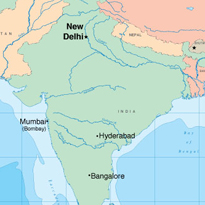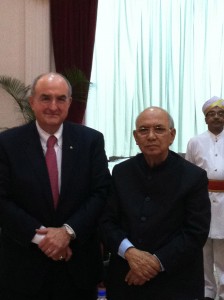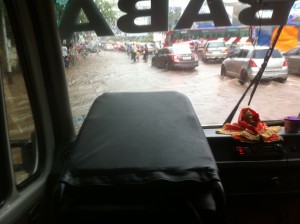Hear President McRobbie speak about India trip
IU President Michael McRobbie will speak on Tuesday (Oct. 4) about the recent trip of the IU delegation to India. His talk will be held from 4 p.m. to 5 p.m. in the Grand Foyer of IU Auditorium.
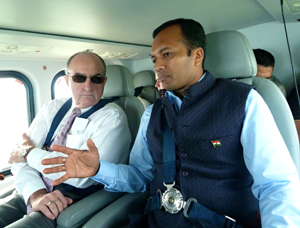
IU President Michael McRobbie and OP Jindal Global University Chancellor Naveen Jindal talk shop on the flight to JGU's campus in Sonipat Sept. 3.
During the talk, there will be an opportunity for questions and informal conversation with members of the IU delegation who are especially eager to welcome those who have a continuing interest in India and its worldwide culture.
The event, organized by Vice President for International Affairs David Zaret and the Dhar India Studies Progam at IU Bloomington, will also be streamed live at http://www.broadcast.iu.edu.
Those planning to attend the event should e-mail ovpia@indiana.edu by Sept. 29.
Tags: delegation, Dhar India Studies Program, India, McRobbie, Zaret
Roll credits ….
Thursday afternoon
Sleep deprivation addressed: Check. E-mail caught up: Check. Jet-lag cured: Let’s just say we’re working on it.
Still, after a good night’s sleep, a happy reunion with my wife and our three dogs and a little red meat I’m well on my way back to normal.
Now that a little time and distance has passed since I left amazing India behind (for now), I wanted to wrap up the blog with a few final thoughts on our 11 days in this interesting and complex place.
Like most places, I suspect, India is much more than what one sees on TV or reads in the newspaper; far greater than the sum of the stereotypical images we too often are fed here in the U.S.
To be sure, we witnessed extreme poverty and experienced traffic that will add gray or subtract hair from one’s head. We also saw our fair share of cows, goats and even the stray camel or two along the road. And, yes, we were counseled against drinking the water.
We also breezed through modern airports in places such as Bangalore and Delhi and witnessed a tech-driven building boom in Hyderabad that any state in the U.S. would die for. We ate wonderful local food (too much of it at times) and were treated like royalty everywhere we went. On our one day off we took in the grandeur of the Taj Mahal, which was worth every minute of the 2-hour train ride each way – and the 3-hour delay in leaving Agra that resulted in us not getting back to our hotel until nearly 2 a.m.
Beyond that, we met people deeply committed to the same things we want at Indiana University: To produce more college graduates and to provide those graduates with the tools they need to succeed in the global world of tomorrow. IU has a lot to offer its counterparts in Indian higher education circles, but rest assured it’s a two-way street. I have no doubt we could learn a few things along the way, too.
I know I’ve written about this at some length already but the magnitude of the issues facing India as result of its sheer size can’t be overstated. A little perspective: We visited four cities whose populations are greater than the entire state of Indiana. By some estimates, India needs to add more than 800 universities in the next decade to have a shot at increasing the percentage of citizens going to college from its current 15 percent to around 25 percent. That’s more than the total number of public universities in the U.S. today.
In some ways, India is a big, messy place with big problems. It’s also a place filled with big ideas and the economies of scale to foster big positive change. It’s sensory overload in every aspect: the sights and sounds, the possibilities and the challenges. One thing it’s not is dull.
—
Before I officially turn the lights off on our India blog, a few thanks are in order to the people who made this trip a success and who in one way or another contributed to my musings. Any mistakes made in my posts are solely my fault and not that of anyone who provided information and assistance.
For starters, a guy couldn’t ask for better traveling partners than those who made this trip. If you ever get the chance to go to India, do it. If you ever get the chance to go with a collection of scholars, do your best to sit as close to them on the bus as possible and soak in every word. I felt smarter just being around this group and their opinions, facts and ideas were very much appreciated.
Our Alumni Association does an outstanding job every day connecting IU’s 500,000 alumns to their alma mater and Eric DeHaan, director of international affairs for IUAA did a superb job setting up two alumni events in India for us.
Our department of International Affairs, led by Vice President David Zaret, was responsible for defining the scale and scope of this trip with the help of our India scholar Sumit Ganguly whose connections proved invaluable in setting up meetings.
In 11 days, we signed five new partnership agreements; met with five prominent Indian politicians, including the vice president; had meetings with four of India’s largest and most successful businesses and set the table for future growth in the country through several other meetings, dinners and events. I’d say we got our money’s worth.
Not only is Laurie McRobbie, IU’s first lady, an outstanding representative for the university she also has my eternal thanks for helping me select a handmade rug in Agra that scored major points with my wife.
A special thanks goes to Shawn Reynolds. Shawn’s day job is as Executive Director of International Partnerships and Strategic Initiatives and he played a major role in setting the agenda for our trip. In India, he also was our CLO – Chief Logistics Officer . Shawn, who is the definition of unflappable, herded the cats and kept track of a dizzying number of travel and meeting details. Not once were we late or did we get lost under his watch.
He also gets credit for my single favorite line of the trip. When asked by one of the members of our group exactly where Infosys was located in Bangalore, Shawn just smiled and said: “It is where it is.” I like a little Zen with my travel.
Finally, President McRobbie deserves major kudos for having the vision to demand that IU aspire to be a world-class university and for backing his words up with a significant commitment of time and energy. His message at each stop on our trip was powerful and on point, and he assembled the right people to ensure we made the most of our time in India.
With that, I will just say Alavidā and thanks for spending a little time with us on our journey through India.
Why We Do What We Do
Tuesday night (Indiana time)
It’s official: I’ve set my watch back to Indiana time, which means our 11-day trip to India has come to close.
I’m actually not really sure what time it is as I write this while flying high over the north Atlantic (we’re roughly above Iceland at the moment). All I know is I’m tired, satisfied with what we accomplished, a little sad to be leaving a fascinating land – and happy to be headed toward family and friends.
A thousand thoughts about India are running through my mind. Twice as many sights, sounds, smells and memories. I promise to share some of my favorites once I get home, get a little sleep and treat my lovely wife to a dinner that includes a nice piece of red meat and a salad.
First, though, I need to clear space in my brain. The idea for this entry was hatched a few minutes after we touched down in Hyderabad Monday morning for the last stop on our journey.
We were wheeling our luggage to yet another minibus with “tourist” emblazoned on the front when David Reingold, our executive associate dean at the School of Public and Environmental Affairs, raised an issue that had been rattling around in the back of my mind for awhile.
(A quick aside: a song titled “Bloomington” by Elizabeth Eckert just popped up on my iPod, thanks to my wife who has loaded all sorts of interesting stuff that I would never otherwise discover. Never heard it before, but it’s making me smile.)
Anyway, I’m enjoying the fact that it’s not 95 degrees in Hyderabad when David says to me: “You know, we need to do an even better job of explaining why we do things like this because there are some people who think it takes away from what we should be doing in Indiana.”
I started to launch into a vigorous defense of the university’s international work and its obvious importance to the future of our students, faculty and the institution, fully realizing I was preaching to the choir.
I stopped. David, one of the many thoughtful, passionate and scary smart people I met on the trip, was right. Like it or not, perception sometimes is reality, which means we need to work a little harder to convince our constituents of things that may seem self-evident to us in the middle of things at IU.
So, here it is, as simply as I can put it. Just a few of the reasons why bringing the world closer to our students – and thrusting them and our good name onto the global stage – is so crucial to building the type of world-class university we deserve in Indiana.
- There’s Sarah, the charming and fearless 24-year-old IU School of Education graduate we met over dinner in Bangalore. Sarah had just come back to Bangalore to teach special education to middle school students after an internship experience in the city earlier this year. Sarah is a Noblesville native who thinks she will return to Indiana at some point to teach. You don’t think her experience in India will benefit students here at some point, do you?
- There were the four American students we met on a tour of the University of Hyderabad Monday afternoon. The university is one of the top graduate institutions in India and runs a terrific “study in India” program for undergrads and grad students alike. These young women, brought together for the semester from California, Georgia, Mississippi and Evansville, were having a great time and learning a lot. They could just have easily been IU students having a life-changing experience, and maybe someday soon it will be.
- There is Deepender Hooda, Dr. Narendra Jadhav and Michael Yoder. All three are IU alums who are playing important roles in India. Hooda, a member of Parliament, and Dr. Jadhav, a member of the country’s planning commission and one India’s leading voices on education, both returned to their homelands after earning a degree at IU. Yoder is the current U.S. Consul in Hyderabad. Having friends like that doesn’t hurt our name global recognition, or opportunities for our students.
- There’s Infosys, the tech giant we visited in Bangalore. Infosys runs an outstanding internship program and promised to put IU on its recruiting list for the first time after our meeting.
- There are the research collaborations made possible by the agreements we signed with a number of universities. If that doesn’t mean all that much to some of you, consider this: IU faculty spent $500 million on research funded by outside sources activities last year, resulting in more than $1 billion in economic activity in Indiana. That means jobs and money flowing into our local economy.
- There’s CH Kiron and his wife, whom we met in our hotel this morning. Kiron owns one of the leading media companies in southern India, and the couple had just returned from Bloomington where they had dropped off their daughter who is a freshman this year. They gushed over their Bloomington experience, and I’m pretty sure we won’t be the only people they tell.
- There’s Cummins, the Indiana-based diesel engine and power generation company where I was fortunate to work for eight years before joining IU in late June. Cummins is a quintessential Indiana manufacturing company – and also probably the most global firm in the state. In fact, Cummins did $2 billion worth of business in India last year and $3 billion in China. At the same time, the company earned record profits and added several hundred jobs in Indiana in the past year in the middle of a lousy U.S. economy. Think it’s a coincidence?
- There’s IU President Michael McRobbie who rightly has been making the point to anyone who will listen than we live in a global society where virtually every career path our students may take will have an international component. Or as he put it to me a couple days ago: “We need to prepare our students for when the day when they are working for a manager from another country, find themselves working on a team with people from around the world or are asked to take a job outside the U.S.” Smart man.
- Finally, there’s my daughter, Sara. She’s currently in Copenhagen completing her final semester of study as a political science major at the University of Delaware. It’s her fourth overseas study opportunity, going back to the summer before her senior year in high school. Each one has broadened her view, made her more independent and confident, and given her a greater appreciation for different cultures. I don’t know where it all will take her, but I do know this: She will leave college far more prepared for the real world than I did.
What it comes down to is that being committed to expanding our reach to India (or China or South Korea or France, for that matter) doesn’t diminish our commitment to the place we call home.
Nearly two-thirds of our students come from Indiana and we’re getting a larger share of the very best the state has to offer. We’re also devoting more money than ever to scholarships and grants for in-state students. In fact, the average net cost of attendance (tuition and fees minus scholarships and grants) for in-state students this academic year is actually lower than last year.
It’s not a zero sum game. This is a case where we actually can have our cake and eat it, too. Cake anyone?
Tags: Cummins, Deepender Hooda, Indiana University, Michael McRobbie, Narendra Jadhav, University of Hyderabad
Building from the ground up
Sunday
I’ve been on this job long enough (just a little more than two months) to know that I have a good gig. What’s not to like about getting to pursue your professional passion at a place that is close to your heart – and getting an office with a view of Indiana and Kirkwood to boot?
Still, every now and again a perk drops into my lap that even I don’t expect. My first helicopter ride falls into that category.
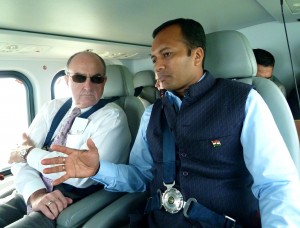
IU President Michael McRobbie and OP Jindal Global University Chancellor Naveen Jindal talk shop on the flight to JGU's campus in Sonipat Sept. 3.
We were scheduled to spend Saturday morning at the IU-OP Jindal Global University joint conference on globalization on the JGU campus in Sonipat, about 40 miles outside of Delhi. Instead of piling into our serviceable but hardly plush seven-seat bus as planned, however, we were the guests of JGU Chancellor Naveen Jindal who also happens to be one of India’s leading business executives and a member of Parliament.
You see, OP Jindal Global University is Naveen Jindal’s baby, formed less than three years ago to honor his late father and to help address the growing need for quality institutions of higher education necessary to boost India’s college graduation rate.
Jindal is among a small, but growing cadre of business leaders turned philanthropists who are pouring their energy – and a lot of money – into i
mproving India’s higher educational system.
Naveen Jindal, earned his MBA at the University of Texas – Dallas before returning home to help lead the family business built by his father and now run by his mother and win a seat in the lower house of Parliament. Now, he’s using his financial resources, business savvy and political clout to build a university that literally is rising out of what had been farmland.
He’s a guy in a hurry (hence the helicopter) who has the wherewithal to make things happen quickly. He has recruited Raj Kumar, a talented lawyer and academic, to serve as Vice Chancellor (the equivalent of president at a U.S. university), who in turn is attracting a strong faculty to JGU.
JGU currently has 600 students in its thr

The largest Indian flag in the nation marks the center of campus at OP Jindal Global University in Sonipat.
ee schools – business law and international affairs — and will grow to approximately 2,500 students over the next few years, as well as add a school of government and public policy next year. It’s the newest school that has Jindal especially excited because he says it fills a desperate need.
“Our politicians need to be better trained so they know how to make the right decisions, and there really are no schools to do this,” Jindal says. “I know such an education would have helped me be a better member of Parliament, and I want to help others.”
JGU will get help in its mission through a partnership with IU’s highly regarded School of Public and Environmental Affairs. The partnership will involve student and faculty exchanges, as well as joint programming. It builds on existing relationships between JGU and the Kelley School of Business and the Maurer Law School.
This latest India partnership is part of IU’s philosophy of working with new universities with a bright future in the hope that our relationship will grow as our partner grows.
Judging from the speed with which Naveen Jindal and JGU are moving, it could be quite a ride.
A matter of scale
Friday morning (and evening)
India is a big place, both in terms of geographic size and population. In many ways size means strength, such as in the rich cultural diversity to be found in India or the enormous (at least half a billion people) and growing labor force in the country.
A large population also means that when there are challenges in society, the scale of the problem can be daunting, making solutions difficult to get your arms around. That’s the case when it comes to education at both the secondary and post-secondary level, according to many of the people with whom we’ve met on the trip.
For example, while India produces some outstanding college graduates, especially in technical fields such as engineering and computer science, only about 15 percent of Indian students attend college, Shri Kapil Sibal, India’s dynamic Minister of Human Resource Development told us yesterday. Sibal, who also serves as India’s chief education official and is leading the effort to open India’s higher education system to foreign universities to a greater degree, would like to see that figure move to 30 percent over the next 10 years.
To do that, Sibal figures India will need to open 800 new institutions of higher education, which leads to some obvious questions: How do you greatly expand a country’s higher education system quickly while maintaining the quality necessary to produce the large number of employable graduates India will need to continue its economic growth in the future? Who is going to pay for it? And where will the faculty come from in a country that already has a dearth of teachers at every level?
The same themes were echoed this afternoon by Vice President Shri M. Hamid Ansari and again this evening by noted IU alumnus Dr. Narendra Jadhav, who is a member of the national Planning Commission in India and one of his country’s leading statesmen.
In his remarks after receiving the Thomas Hart Benton Medal from President McRobbie for his outstanding service to India, Dr. Jadhav spoke passionately on the challenges of nearly doubling the percentage of college students in India while improving the quality of the higher education system. It’s a challenge, he says, that can only be met by the government and private sector working together.
Partnerships between foreign universities, such as IU, and Indian institutions that result in student exchanges, faculty collaboration and even joint degree programs are all helpful, but Minister Sibal made it clear that he thinks such activities are only a first step it comes to filling India’s daunting higher education needs. Distance education brings with it inherent quality control concerns, Sibal argues, and paying foreign faculty a premium to come to India to help fill the faculty gap would be political untenable in a country where professorial salaries are largely set and funded by the government.
The prospect of U.S. or other foreign institutions setting up campuses in India or partnering with foreign universities in larger ways than most collaborations today holds some promise for Sibal, but building brick-and-mortar facilities is an expensive proposition for a foreign university, especially in times of reduced government funding and economic distress.
So, where does that leave the future of India’s higher education system? It seems clear that it’s not a problem that can be solved today or even tomorrow, but it’s heartening to see so many smart, committed people working on the issue.
In addition to thoughtful leaders like Sibal, Ansari and Jadhav leading Indian business executives also are tackling the issue in various ways. The Azim Premji Foundation, named for the founder of Wipro one of India’s largest IT companies, has committed approximately $2 billion to the cause of improving the quality of teaching in India at all levels and is even creating its own university to train future generations of educators.
We met with a leader with the Azim Premji Foundation while in Bangalore, who laid out his organization’s ambitious plans, the scale of which border on the audacious – but maybe that’s what it takes to meet a challenge of this magnitude. Today, we celebrated the start of a two-day conference between IU and OP Jindal Global University. JGU is a private university started by Naveen Jindal who runs Jindal Steel and Power Co., which is part of the Jindal Group, a nearly $1 billion organization. The university was started less than three years ago to promote public service through education, and IU and Jindal formalized a partnership tonight.
Jindal University is another bold stroke backed by one of India’s most successful business executives who is committed to give back. And maybe in that lies the answer to India’s formidable education challenges. It’s going to take a lot of people doing their part – and inviting like-minded partners from around the world to do what they can to join in the movement. Maybe efforts like ours in India are just a first step, but every journey has to start somewhere.
Tags: Hamid Ansari, Narendra Jadhav, OP Jindal Global University
Big (and long) day in Delhi
Thursday morning
Well, there was no catnap on the early morning flight from Bangalore, not that I really held out much hope (wide body + middle seat = no sleep).
Fortunately, there was plenty of activity on the ground to keep us all awake and alert through a long day. Before I get to that, a few words about our current “home” town:
Delhi, located in northern India, is the second largest city in the country with a population between 14 million and 16 million people depending on who you ask and what you count (what’s 2 million people between friends, especially in a country of 1.2 billion?). It’s also the national capital, which explains the wide boulevards, manicured landscaping, grand buildings and high walls that we saw in abundance on our travels yesterday.
It’s also the third distinct climate we’ve encountered in three cities. Hot and sunny. Did I mention hot?
Our first day in Delhi yielded two new partnerships with the Indian Institute of Management, the leading business school name in India. We started by signing a memorandum of understanding with IIM Lucknow that will expand and formalize an already strong relationship between the IU Kelley School of Business and IIM Lucknow (or IIML as its friends call it).
IIML is one of the oldest and best-regarded of the 13 IIM schools in India. It may also be the most entrepreneurial. Under the direction of Director Devi Singh, IIML is the only one of the IIMs to have multiple campuses and its campus in Noida (about an hour outside Delhi) offers executive and part-time MBA programs geared toward working adults.
Kelley School faculty have already traveled to teach at IIML and the two schools are working out a way for IIML’s executive MBA students to do a short-term study abroad program taught by Kelley School faculty. The chemistry between Director Singh and Kelley School Dean Dan Smith was evident as the two ping-ponged ideas about the study abroad program back and forth yesterday. Fun to watch.
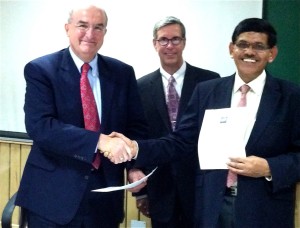
IU president Michael McRobbie, Kelley School of Business Dean Dan Smith and IIM Lucknow Director Devi Singh are all smiles after the two schools signed a partnership agreement Aug. 31
After the signing with IIM Lucknow we traveled to the Constitution Club (a venerated social club that caters to Members of Parliament) in New Delhi, to sign an MOU with IIM Rohtak, which is the only IIM to serve India’s capital region. It’s also the newest IIM and one of special interest to Member of Parliament Deepender Hooda.
Hooda represents Rohtak, district in the Indian state of Haryana about 40 miles northwest of Delhi. He’s also a Kelley School graduate (2003). Hooda was youngest member of Parliament ever elected in Haryana and played an instrumental role in bringing his alma mater and his IIM together. How’s that for the global strength of an IU degree?
Our relationship with IIM Rohtak likely will start with research collaborations and doctoral student exchanges, but we hope to eventually partner with IIMR on an executive MBA program for Indian professionals.
In contrast to our MOU signing with Lucknow, which attracted no media coverage, our Rohtak signing drew a large and raucous crowd of print and television reporters and photographers. As much as we’d like to think otherwise, the main attraction was Hooda (or Deep, as he’s affectionately known by his Kelley School friends).
In some ways, the media became the story (at least for us) as they jostled for space, ordered the speakers not to stray from the clutch of microphones on the table, argued with one another – and at one point even stopped Hooda during his remarks so a microphone could be added. I’m trying to picture that happening at a press conference featuring Gov. Mitch Daniels.
It’s a testament, we’re told, to the ongoing media explosion in India and in the end, it was all good. We undoubtedly received coverage in a part of India that probably hadn’t heard of IU before, and our signing found its way into at least two of the country’s largest newspapers.
As it turns out, we were treated to the full journalism spectrum yesterday when we hosted a spirited and high-minded dinner with reporters from many of the top newspapers and magazines working in India set up by Professor Ganguly (I’m convinced the guy knows half of the people in India). We got to tell our story and learned a lot about Indian politics and the educational system – all over another wonderful Indian meal.
To this former newsie, it was the perfect ending to a long and productive day.
Tags: Deepender Hooda, IIM Lucknow, IIM Rohtak
Bangalore: Thanks for the Memories
(EARLY Wednesday morning)
Greetings from 31,000 feet over India heading north out of Bangalore.
Indian hospitality is well-known among international travelers and it was on full display last night as members of our delegation were guests of His Excellency Mr. H.R. Bharadwaj, governor of the state of Karnataka, where Bangalore is located.
Set up by our friends and partners at OP Jindal Global University, the event provided a rare opportunity for our leaders to get the ear of a leading Indian statesman. The governor is keenly interested in both the quality of education and the legal system in his country, prompting a discussion involving President McRobbie, IU Maurer School of Law Dean Lauren Robel. Raj Kumar, Vice Chancellor at OP Jindal, and others.
After an introductory chat in the foyer of the governor’s residence, we were treated to a captivating performance of traditional southern Indian music by a quintet of talented musicians – three on stringed instruments and two playing traditional percussion instruments.
No Indian event, it seems, is complete without multiple dishes of wonderful local cuisine accompanied by more chances to met new friends, and last night’s guests included members of the local business, academic and government communities.
The evening was a perfect way to cap off two productive days in Bangalore. Now it’s up early (we left the hotel at 4:30 to catch our flight to New Delhi) for the longest day of the trip.
President McRobbie and Kelley School of Business Dean Dan Smith will sign partnership agreements with two management institutes and the group will visit a third university to discuss collaboration opportunities. We end the day with what should be an interesting informal dinner discussion with some of the leading journalists in the city.
Before leaving Bangalore, I want to say a special thanks to all those who made our stay comfortable. Treating guests like family is ingrained in the Indian culture and it shows everywhere. The hospitality is very much appreciated.
Now, if you’ll excuse me, it’s time to try to catch a catnap before we touch down in New Delhi for the next stage in our adventure.
Tags: Bangalore, Indiana University, Maurer Schol of Law, Michael McRobbie
Visiting India’s high tech capital
Bangalore (Monday) –
After a relatively quiet Sunday highlighted by lunch with Indian Ambassador Rajendra Abhyankar and the U.S. Consul General in Mumbai Peter Haas and his wife, Amy, it was south to Bangalore last night for two days in one of the fastest-growing cities in Asia.
That growth has been driven by a high-tech boon that has seen Bangalore become home to many household names in the tech industry and a
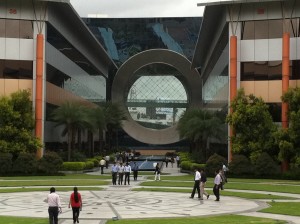
The Infosys campus engages its employees with eye-catching architecture, manicured grounds and ample amenities.
magnet for U.S. investment over the past decade.
Bangalore is an interesting contrast to Mumbai, starting with the geography. Bangalore sits 3,000 feet above sea level, making it cooler than Mumbai. It’s also, blissfully, much drier — although we managed to bring a little rain with us today, it seems. Distinguished Professor Sumit Ganguly, our resident Indian expert on the trip (and I do mean EXPERT) says Bangalore is called the “Garden City” largely due to its moderate climate and abundance of green space.
It also has an abundance of high-tech firms, earning Bangalore the distinction as the “Silicon Valley” of India. We visited two of the largest today with trips to the Indian R&D headquarters of U.S. – based Cisco Systems and to Indian tech giant Infosys. We also met with the leadership at the Indian Institute of Science, one of the country’s most prestigious research institutions.
For the tech folks in the group, it was a chance to talk teraflops and gigabytes, high performance computing and cloud networks. For others (me), it was just pretty cool to be around people much smarter than me doing things I can only imagine.
At Infosys, we met with co-Chairman Kris Gopalakrishnan and two members of his education team at the company’s gorgeous and architecturally captivating corporate campus.
Twenty thousand Infosys employees walk, bike, work and play on an expansive campus that would be the envy of many a university. In fact, take the ties off the male employees, and the place had the look and feel of a classic college campus. As Kris explained, Infosys feels strongly that “in order to be a world-class company, you have to challenge yourself to be world-class in everything you do, including facilities.”
It’s a point well taken and backed up by the fact that Infosys also runs a world-class internship program for top-flight college students from around the world — a package that includes all travel and housing expenses, as well as a stipend.
This revelation resulted in an animated discussion led by President McRobbie and Dean Schnabel about the possibilities of student (and faculty) partnerships with Infosys. As a result, Infosys has pledged to add IU to its internship recruiting rotation with the hope of creating opportunities for our students to work at one of the most innovative and dynamic firms in the industry.
We also came away from our meeting with a commitment on both sides to explore areas where our faculty could team with Infosys on research. Given the breadth of the work being done by our School of Informatics and Computing, the possibilities for collaboration are pretty exciting, Dean Schnabel says.
Tags: Bangalore, Bobby Schnabel, Indiana University, Infosys, IU, Michael McRobbie
Meeting the IU family
Taj Mahal Palace Hotel (Saturday night)
This is IU so the question was bound to come up, even 8,000 miles from home.
“So how’s the basketball team going to do this year?” asked a young Mumbai alumnus shortly after introducing himself.
After assuring him that we were going to be better once again this year, and that I was convinced Coach Crean had the Hoosier hoops ship headed in the right direction (someone please tell Coach I was out recruiting the fan base for him, I’m dying to get a Twitter shout out), talk turned to another of the prevalent topics of the evening: The beauty of the IU experience.
“I really miss Bloomington.”
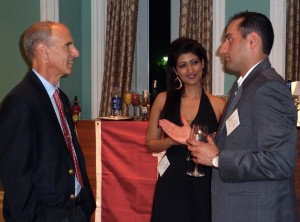
School of Informatics and Computing Dean Bobby Schnabel speaks to IU alumni during a reception at the Mumbai Taj Mahal Palace Hotel.
“I had a great time at IU.”
“I learned a lot from my IU experience.”
The drumbeat of praise and fond memories for IU continued all evening as we shared dinner and stories with nearly 40 members of the Mumbai chapter of the IU Alumni Association at a wonderful event at our hotel. Chapter Founder and President Gaurav Parikh (BS ’02), a high-energy Kelley School graduate who returned home to Mumbai to help run the family business, introduced President McRobbie.
The president spoke of his only other visit to India – when he was 4-years-old and his family stopped in Mumbai (then Bombay) en route from Australia to England by ship – and then shared the expected highlights of our current trip to India, and the strong ties between Indiana, IU and India.
He also shared a little history, such as the fact that IU’s first Indian graduate was Konigapogu Joseph Devadanam, who received a BA in psychology in 1930, and that in August 1948 IU President Herman B Wells joined about 200 people from the Bloomington campus and the community, along with IU’s Indian students, to celebrate the first year of India’s independence.
Eric DeHaan, director of international alumni relations, tells me that IU has more than 2,300 Indian alumni, with approximately 400 currently living in India. It was great fun to make new friends from among the IU family and terrific to see that no matter where our alumni live, IU is never far from their hearts.
Thanks to Eric for pulling together an outstanding event and to Gaurav for his leadership of the chapter. And, of course, to our alumni who weathered the steady rain (did I mention it was monsoon season here) for providing a perfect ending to our first full day in India.
Tags: Indiana, Indiana University, IU Alumni Association, Michael McRobbie, Mumbai
Monsoon season
There’s rain. There’s monsoon. And then there’s what we drove through this afternoon on 0ur way back from a very productive meeting at the Indian Institute of Technology, Bombay.
Mumbai is heading into the final month of monsoon season, which brings up to a foot-and-a-half of rain – a month – to these parts. So when our driver said he had seldom seen a deluge like the one that doubled the driving time back to our hotel I didn’t know whether to be impressed or a little bit worried. Worry won for a few brief moments when the driver decided to “ford” the far left lane of the road, which had been turned into a flash-flood river.
All’s well that ends well, and our safe arrival at the hotel a few minutes later prompted President McRobbie to quip to the driver that “(you) drive like Clint Eastwood – and I mean that as a compliment.”
Our visit to IIT Bombay started – and ended – well. Although the rain meant a campus stroll was out of the question, our short drive from the main gate to the director’s office provided a glimpse of the lush, scenic campus that is home to 10,000 of India’s brightest college students, most of them dedicated to engineering and computer science. IIT Bombay was the second of India’s 15 technology universities to be established and is considered one of the best IIT schools.
Our meeting was designed to begin a dialogue between the two universities and explore areas of possible collaboration. As is often the case when I travel, I’m struck by the commonality of issues that face organizations in different locations. For example, Like IU, IIT Bombay is looking for ways to increase opportunities for its students to study abroad given the increasingly global world in which today’s students will soon be working (trivia for the day: 25 percent of IU Bloomington undergraduate students will do overseas study while on campus.)
One of the most interesting parts of the discussion revolved around areas of common interest in computing and informatics (my thanks to School of Informatics and Computing Dean Bobby Schnabel who provided this layman with the most succinct description of Informatics he has ever heard: Applied computing). IU has one of the broadest computer sciences schools in the country, with strength in a number of areas including cyber security, which drew a lot of interest from our IIT hosts.
No new deals were reached, but friendships were made – and in the case of President McRobbie and Director of IIT Bombay they were strengthened – and groundwork laid for possible future collaboration between two outstanding universities. In particular, Dean Schnabel and Vice President for International Affairs David Zaret plan to continue discussions with IIT Bombay on partnership opportunities.
And through it all, we somehow managed to stay dry. Mostly.


